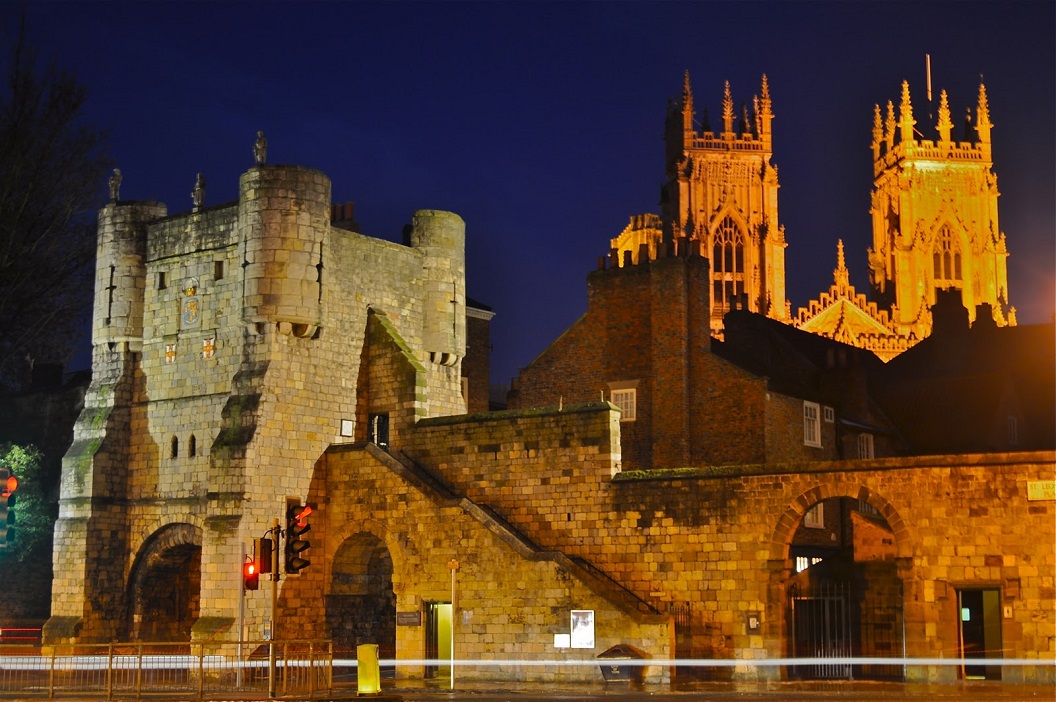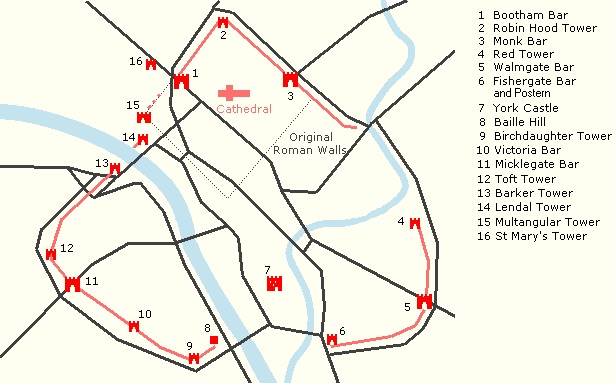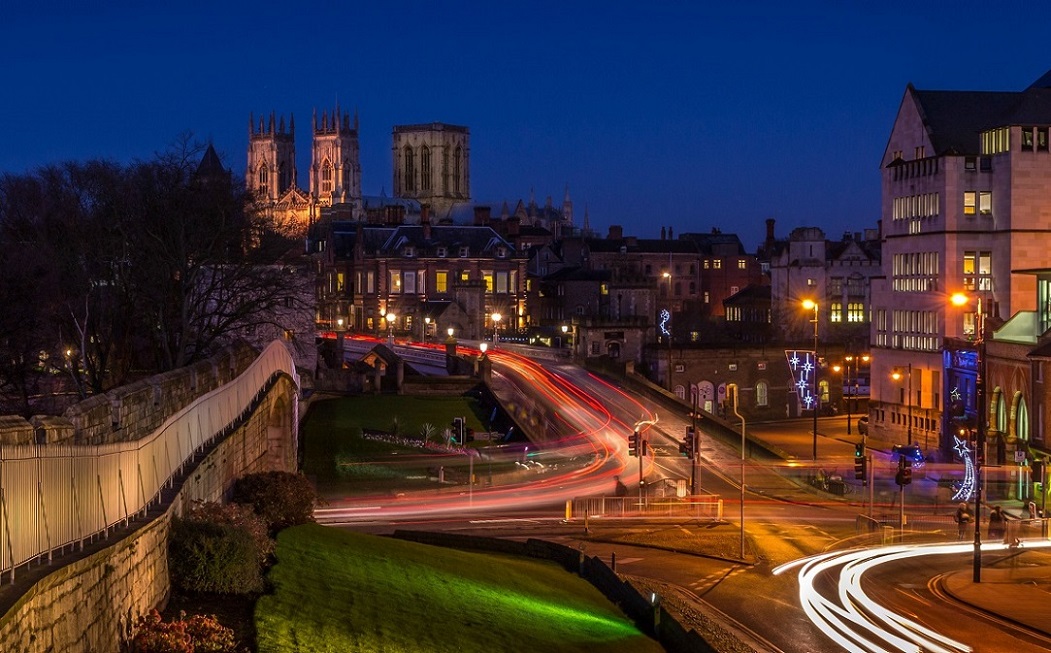York City Walls: Difference between revisions
No edit summary |
|||
| Line 27: | Line 27: | ||
<br> | <br> | ||
<br> | <br> | ||
== Post Roma Praxis == | |||
[[File:York city walls night 2.jpg]] | [[File:York city walls night 2.jpg]] | ||
<br> | <br> | ||
<br> | <br> | ||
The Danes occupied the city in 867. By this time the Roman defenses were in poor repair, and the Danes demolished all the towers save the Multangular Tower and restored the walls. | |||
The majority of the remaining walls, which encircle the whole of the medieval city, date from the 12th – 14th century, with some reconstruction carried out in the 19th century and later. From the east corner of the Roman walls, the medieval wall extends to Layerthorpe Bridge. After the bridge, the King's Fishpool, a swamp created by the Normans' damming of the River Foss, provided adequate security for the city, and no walls were ever built in this area. | |||
The walls resume beyond the now canalized Foss at the Red Tower, a brick building which has been much restored over the years. They continue south and west around the Walmgate area, terminating in another tower (Fishergate Postern), near York Castle, which was formerly surrounded by its own walls and a moat. | |||
A small stretch of wall on the west side of Tower Gardens terminates at Davy Tower, another brick tower located next to the River Ouse. This originally ran up to the castle walls, with a postern on Tower Street. | |||
Beyond the Ouse, the walls resume at Skeldergate, where there was once another postern. They climb past Baile Hill, take a right turn and proceed north-west parallel to the Inner Ring Road. Near the railway station, they turn right again in a north-easterly direction, finishing at Barker Tower on the Ouse. | |||
Barker Tower was once linked by a chain across the river, parallel to the 19th-century Lendal Bridge. A small stretch of wall then leads to the entrance to Museum Gardens, the Multangular Tower and the original line of the Roman walls. | |||
Today the walls are a scheduled ancient monument and a grade I listed building. | |||
Revision as of 20:16, 26 March 2015
Introduction
The English city of York has, since Roman times, been defended by walls of one form or another. To this day, substantial portions of the walls remain, and York has more miles of intact wall than any other city in England. They are known variously as York City Walls, the Bar Walls and the Roman walls (though this last is a misnomer as very little of the extant stonework is of Roman origin, and the course of the wall has been substantially altered since Roman times).

The Roman Walls

The original walls were built around 71 AD, when the Romans erected a fort (castra) occupying about 50 acres or 21.5 hectares near the banks of the River Ouse. The rectangle of walls was built as part of the fort's defences. The foundations and the line of about half of these Roman walls form part of the existing walls, as follows:
- -- a section (the west corner, including the Multangular Tower) in the Museum Gardens
- -- the north-west and north-east sections between Bootham Bar and Monk Bar
- -- a further stretch between Monk Bar and the Merchant Taylors' Hall, at the end of which the lower courses of the east corner of the Roman wall can be seen on the city-centre side of the existing wall.
The line of the rest of the Roman wall went south-west from the east corner, crossing the via principalis of the fortress where King's Square is now located. The south corner was in what is now Feasegate, and from here the wall continued northwest to the west corner. The point where the wall crossed the via praetoria is marked by a plaque in St Helen's Square near the Mansion House.
Multangular Tower
The Multangular Tower in the Museum Gardens is the most noticeable and intact structure remaining from the Roman walls. It was constructed as part of a series of eight similar defensive towers. The walls are almost certainly the creation of Septimius Severus, however the Multangular Tower is probably a later addition of Constantine the Great around 310–20 AD. It has ten sides, based on a regular fourteen-sided figure designed so that a circle through the internal angles of the internal face is tangential to the curve. The rear four sides are missing to provide access to the interior of the tower.
A low plinth or skirt extends out from the lowest course. It stands almost 30 feet (9.1 m) tall, has an external diameter of 48.5 feet (14.8 m) at the base and 46 feet (14 m) above the skirt. Length of each side varies from 7.5 feet (2.3 m) to 11 feet (3.4 m) on the inner face. The tower projects beyond the curtain wall to a distance of 36.75 feet (11.20 m). The foundations are concrete, atop which the tower extends having a rubble and mortar core between ashlar faced courses of small mangesian limestone blocks. At 15 feet (4.6 m) a scarcement reduces the thickness of the wall from 5 feet (1.5 m) to 3.25 feet (0.99 m), which continues for a further 4 feet (1.2 m) before being capped by 11 feet (3.4 m) of 13th century masonry in which arrowslits can be seen.
Post Roma Praxis

The Danes occupied the city in 867. By this time the Roman defenses were in poor repair, and the Danes demolished all the towers save the Multangular Tower and restored the walls.
The majority of the remaining walls, which encircle the whole of the medieval city, date from the 12th – 14th century, with some reconstruction carried out in the 19th century and later. From the east corner of the Roman walls, the medieval wall extends to Layerthorpe Bridge. After the bridge, the King's Fishpool, a swamp created by the Normans' damming of the River Foss, provided adequate security for the city, and no walls were ever built in this area.
The walls resume beyond the now canalized Foss at the Red Tower, a brick building which has been much restored over the years. They continue south and west around the Walmgate area, terminating in another tower (Fishergate Postern), near York Castle, which was formerly surrounded by its own walls and a moat.
A small stretch of wall on the west side of Tower Gardens terminates at Davy Tower, another brick tower located next to the River Ouse. This originally ran up to the castle walls, with a postern on Tower Street.
Beyond the Ouse, the walls resume at Skeldergate, where there was once another postern. They climb past Baile Hill, take a right turn and proceed north-west parallel to the Inner Ring Road. Near the railway station, they turn right again in a north-easterly direction, finishing at Barker Tower on the Ouse.
Barker Tower was once linked by a chain across the river, parallel to the 19th-century Lendal Bridge. A small stretch of wall then leads to the entrance to Museum Gardens, the Multangular Tower and the original line of the Roman walls.
Today the walls are a scheduled ancient monument and a grade I listed building.